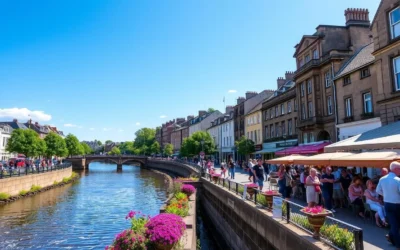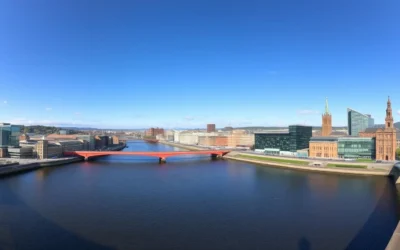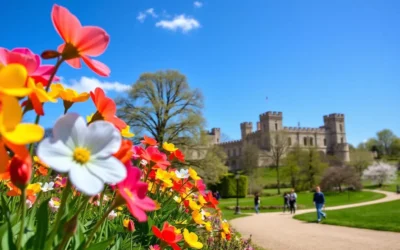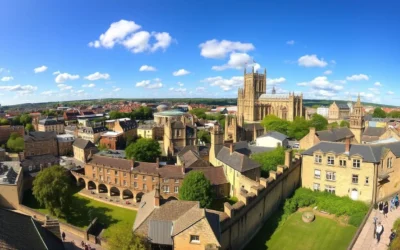1. London, England – Population: 8,982,000
Known for its iconic landmarks like the Tower of Big Ben, Buckingham Palace, and the British Museum.
2. Birmingham, England – Population: 1,141,000
Famous for its industrial heritage and vibrant arts and music scene.
3. Manchester, England – Population: 545,000
Known for its football teams (Manchester United and Manchester City) and cultural scene.
4. Glasgow, Scotland – Population: 635,000
Famous for its vibrant arts scene, museums, and Scottish heritage.
5. Leeds, England – Population: 789,000
Known for its diverse cultural attractions and shopping districts.
6. Sheffield, England – Population: 584,000
Famous for its industrial history, especially steel production, and its outdoor parks.
7. Bradford, England – Population: 537,000
Known for its rich history in textile production and its UNESCO City of Film status.
8. Edinburgh, Scotland – Population: 530,000
Famous for the Edinburgh Festival, its historic castle, and Georgian architecture.
9. Liverpool, England – Population: 498,000
Known for The Beatles, its waterfront, and a rich maritime history.
10. Cardiff, Wales – Population: 364,000
Famous for its rugby culture, Cardiff Castle, and being the capital of Wales.
11. Coventry, England – Population: 371,000
Known for its automotive history and the Coventry Cathedral.
12. Nottingham, England – Population: 321,000
Famous for the legend of Robin Hood and its medieval architecture.
13. Newcastle upon Tyne, England – Population: 148,000
Known for its iconic bridges and nightlife, as well as its history in shipbuilding.
14. Stoke-on-Trent, England – Population: 249,000
Famous for its pottery industry and historic ceramics.
15. Kingston upon Hull, England – Population: 260,000
Known for its maritime heritage and cultural offerings like The Deep aquarium.
16. Southampton, England – Population: 252,000
Famous for its port, being the birthplace of the Titanic, and its maritime history.
17. Wolverhampton, England – Population: 262,000
Known for its industrial history and being a hub for manufacturing.
18. Leicester, England – Population: 355,000
Famous for Leicester Cathedral, the discovery of Richard III’s remains, and its cultural diversity.
19. Derby, England – Population: 255,000
Known for its role in the industrial revolution, especially in the railway sector.
20. Aberdeen, Scotland – Population: 198,000
Famous for its oil industry, granite architecture, and proximity to the North Sea.
21. Brighton & Hove, England – Population: 290,000
Known for its beach, pier, and being a cultural hotspot with a vibrant LGBTQ+ scene.
22. Blackpool, England – Population: 142,000
Famous for its seaside attractions, including the Blackpool Tower and Pleasure Beach.
23. Oxford, England – Population: 154,000
Known for the University of Oxford, one of the oldest and most prestigious in the world.
24. Cambridge, England – Population: 130,000
Famous for the University of Cambridge, rich in history, architecture, and academic achievements.
25. Peterborough, England – Population: 202,000
Known for its cathedral and historical significance in the medieval period.
26. Norwich, England – Population: 213,000
Famous for its medieval buildings, including Norwich Cathedral, and its historical markets.
27. Swindon, England – Population: 221,000
Known for its railway history and proximity to the Cotswolds.
28. Bath, England – Population: 89,000
Famous for its Roman baths and Georgian architecture.
29. Milton Keynes, England – Population: 229,000
Known for its modernist architecture and being a center for commerce and education.
30. Hastings, England – Population: 92,000
Famous for the Battle of Hastings in 1066 and its seaside views.
31. Exeter, England – Population: 130,000
Known for its medieval cathedral and rich Roman history.
32. York, England – Population: 211,000
Famous for its Roman, Viking, and medieval history, including York Minster.
33. Guildford, England – Population: 77,000
Known for its historical landmarks, including Guildford Castle and its vibrant town center.
34. Wakefield, England – Population: 328,000
Known for its historical significance and beautiful parks and gardens.
35. Southend-on-Sea, England – Population: 182,000
Famous for its pier, the longest in the world, and its beach.
36. Redcar, England – Population: 63,000
Known for its coastal views and its iron and steel industries.
37. Slough, England – Population: 164,000
Famous for its proximity to London and being a key area for business and commerce.
38. Woking, England – Population: 67,000
Known for its proximity to London and its shopping centers.
39. Chester, England – Population: 120,000
Famous for its Roman walls, medieval architecture, and Chester Zoo.
40. Worcester, England – Population: 100,000
Known for Worcester Cathedral and its famous sauce, Worcestershire sauce.
41. St Albans, England – Population: 147,000
Famous for its Roman history and St Albans Cathedral.
42. Darlington, England – Population: 105,000
Known for being the home of the world’s first passenger railway.
43. Swindon, England – Population: 221,000
Known for its railway history and being a center for commerce and education.
44. Aberystwyth, Wales – Population: 18,000
Famous for its university, seafront, and historical sites.
45. Newport, Wales – Population: 151,000
Known for its historical bridges and proximity to Cardiff.
46. King’s Lynn, England – Population: 42,000
Famous for its maritime history and Old Town.
47. Halifax, England – Population: 88,000
Known for its industrial heritage, especially in textiles and wool.
48. Caerphilly, Wales – Population: 66,000
Famous for Caerphilly Castle, the largest castle in Wales.
49. Milton Keynes, England – Population: 229,000
Known for its modernist design, large parks, and major shopping centers.
50. Shrewsbury, England – Population: 72,000
Famous for its Tudor-style buildings, Shrewsbury Castle, and the birthplace of Charles Darwin.
The above is subject to change.
Check back often to TRAVEL.COM for the latest travel tips and deals.




